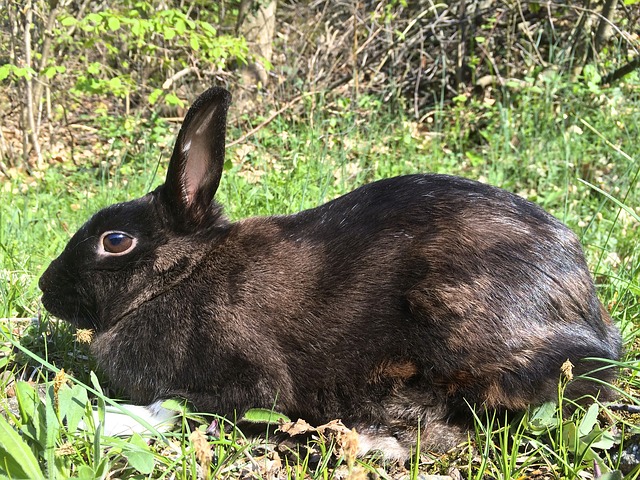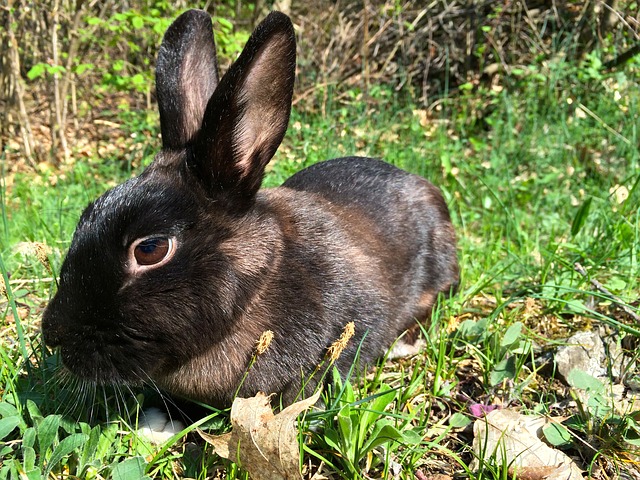
The Silver Fox Rabbit was originally bred for fur and for meat. It is the third breed to have originated in the United States. In 1925, the name was originally the American Heavyweight Silver. Later on, the name changed to American Silver Fox and then it just became Silver Fox. Before the 1970’s, there were two known categories in Silver Fox. These were Blue and Black. Since then, the Blues have been dropped. This breed is not recognized in other countries for now.
The actual genetic makeup has never been divulged to anyone. However, the original breeder who created the Silver Fox breed, had two known breeds. He had the Checkered Giants and then the Champagne D'Argents. It is likely that he had used these two originally and then mixed the litter with the American Blue. It makes sense due to the coloring, the length of fur and the size. This was the first breed that had the ability of 65% of its live weight for meat.
Nature
The Silver Fox is a docile and gentle rabbit. They make excellent mothers, they usually have large litters and they can even be excellent foster mothers when needed. The Silver Fox Rabbit is known to be one of the breeds that is rare. It is not easy to find this breed. In order to maintain this gentle and docile nature, the Silver Fox should be out of its hutch for a good portion of the day.
Having a rabbit run is ideal. This allows the rabbit to move around and be active. Be certain there is a net covering or chicken wire covering over the top of the run to prevent predators from entering. This breed of rabbit will develop a strong and deep love for its humans. The more time that this breed spends with humans and other animals, the gentler they become.
Babies
When a litter arrives, they are born with black, or dark blue fur. The silver begins to emerge at about the 4 week mark. This silvering of the fur takes roughly 4 months to complete. As they grow, the males will reach a weight of up to 11 pounds, the females will reach up to 12 pounds. When this Silver Fox breed rabbit should be socialized starting when they are young. They are great rabbits to have as show rabbits and as family pets.
Features

The Silver Fox Rabbit has ears that stand straight up, their eyes are a medium brown color and average sized. Again, the Silver Fox is quite a sociable and calm rabbit, as long as it is trained early on in life.
Fur
The fur is extremely thick and dense. The fur on the Silver Fox will generally grow to 1 ½ inches to 2 inches in length. One difference with this breed is that when you pet this rabbit and rub the fur in the opposite direction, it will stand erect until it is smoothed back down in the normal direction. In other words, it is not what they call roll back fur. The Silver Fox Rabbit can come in a variety of colors such as blue, black, chocolate and lilac. The only one that is recognized by the ARBA is the Black Silver Fox.
Health
The Silver Fox breed of rabbit is not prone to any diseases. Nor do they have a predisposition to any diseases. For the most part, this breed is overall one of the healthiest breeds you can find. They should still be seen routinely by the veterinarian, especially for ear mites, as they can have a buildup of ear wax. They should also receive a small amount, about a pea sized amount, twice a year.
All rabbits are prone to their teeth becoming overgrown. Their teeth are maintained easily by giving them a diet that is 70% of good quality hay. They gnaw on the hay which helps keep their teeth at normal size. The rest of the diet could be rabbit pellets, leafy greens and a piece of fruit once in a while.
This breed has the possibility of being trained and then coming when you call its name. They can also be litter box trained but this is more of a difficult challenge. With lots of patience, and giving rewards for accomplishing the training activity, will help. This breed is not the smartest of rabbit breeds, when they feel panicked or stressed, this rabbit will act on instinct. Just as they would if they were being chased by a predator. Loud noises, or quick movements would be something that would cause the Silver Fox Rabbit to be jumpy and is scared easily.
The Silver Fox Rabbit can live for a long and happy time. The average life span of the Silver Fox Rabbit is 7 to 10 years. Every rabbit is different, some like simple toys while others need something that gives more stimulation. The Silver Fox Rabbit will do fine living indoors with the human family and also outdoors as long as it has a warm and safe shelter. Being so docile, they are very low maintenance also.
The following are the issues that could affect the Silver Fox Rabbit.
- Flystrike is where the flies will lay eggs on the rabbit’s skin. This is usually done near an open sore, a dirty bottom or consistently wet fur. As the eggs hatch, the maggots will burrow into the skin. This can happen in a very short amount of time and can become fatal.
- Teeth in rabbits never stop growing. Chewing on a good quality hay throughout the day is what helps keep the teeth from growing too large. It is recommended that 70% of the rabbit’s diet comes from hay. This will alleviate the issue of overgrown teeth.
- Heat. The Silver Fox rabbit does not cope well in hot weather. As the owner, you need to ensure that there is a constant supply of fresh cool water, and also that the hutch, if the rabbit is outdoors, has a shady area when the rabbit can get away from the heat.
Care and Maintenance

There is not much grooming you will have to do with your Silver Fox Rabbit. When the time comes for shedding, you can give routine brushings to help remove the excess hair. The Silver Fox rabbit does shed during the spring and the fall, so be prepared to give extra brushings during those times. The Silver Fox Rabbit should never have sugary treats. No rabbit should. Iceberg lettuce is also a dangerous food for rabbits. The iceberg lettuce contains too much lanandum which can be fatal for your furry little friend.
Rabbits will self-clean when it comes to their fur. You will need to trim the rabbit’s nails often. This can be done by a groomer or by you. Their nails do grow quickly and should be kept trimmed routinely. However, if the rabbit has a kennel run or is outdoors with space to move, they will wear their nails down slightly. You will still need to keep them trimmed. Your rabbit's ears also need to be checked often. When a rabbit is outdoors, they tend to get a dirt build up that could harbor mites if it is not checked.
If the Silver Fox rabbit is not given toys or plenty to do, it may start running around its cage looking for something to do. It is best to ensure that you have plenty of toys and other objects that a rabbit can chew on and play with. Remember, rabbits, including the Silver Fox rabbit love to be social. As long as you begin training your Silver Fox rabbit to be around people starting at a very young age, they will handle humans well.
The Silver Fox’s hutch must be large enough so that their food is kept away from where they sleep, also their litter area should be well away from the food and the sleeping area. The suggested size of a hutch for this large breed rabbit is a 2 foot by 5 foot area. This gives them room to move. It is still preferable to give them an area where they can run for a while. In essence, like a dog kennel run. This will also keep your rabbit busy and a busy rabbit is a happy rabbit.
As always, when you are researching a Silver Fox rabbit, look for registered breeders. They will have kept perfect records of all medical notes, the parentage, the family line, etc. The breeder will also be able to provide registration papers. If you are told that they cannot give you papers, leave the area. This is likely telling you that the breed is not clean, not pure.
Even at an animal shelter, there is no guarantee that you will have a pure breed Silver Fox rabbit. If you are wanting the Silver Fox as a show rabbit, you will need to have registration papers.





